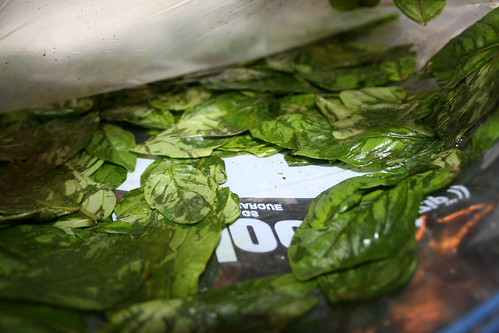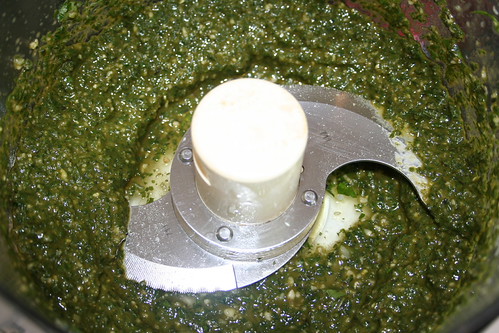 This post is part of an ongoing series on Italian cookery, affectionately known as “The Spaghetti Capers.”
This post is part of an ongoing series on Italian cookery, affectionately known as “The Spaghetti Capers.”
You may remember that I previously professed my love for Barbara Lynch, with promises of more posts to come. I don’t remember when I first took a special interest in her career — I want to say it was after Sportello was featured in Saveur magazine, and I learned of her Italian venture? I was already an avid fan by the time she was featured on the cover of the Boston Globe magazine (great article — I encourage you to read it!); and was therefore thrilled when I stumbled across her segment on the Cooking Channel where she walks the viewer through the recipe for Ricotta Gnudi.
Ricotta Gnudi! What, you may ask, is ricotta gnudi, anyway? From what I’ve read, gnudi is, much like it sounds, the Italian word for nude. Can’t wait to see what kind of readers are going to stumble across my blog now that the words “nude Italian” are on here… Essentially, gnudi are akin to ravioli filling…with nothing enclosing them; instead, you roll them out like gnocchi. However, unlike gnocchi–or “little sinkers” as my grandfather always calls them–gnudi are absolutely pillow soft and light. It’s like eating happy little Italian clouds (channeling my inner Bob Ross).
The best way to make ricotta gnudi, of course, would be to make your own ricotta. My cheesemaking party plans have been stymied for the past year, however, so I was more than happy to use the fresh ricotta from Narragansett Creamery instead (see prior raves here and here).
Shall we kick off this gnudi party, then? Start by mixing together your ricotta with some flour, an egg, parmesan, salt and white pepper.

Your dough will be super sticky and a little tricky to work with. This is a good thing — this is why the gnudi will be light and airy.

Next, gently roll out your dough by hand into a log and cut into bite size pieces. Hard to work with = messy. This is OK. Embrace the mess. (That’s actually one of my mantras for the year…but that’s another story).

Roll the pieces into balls and use a gnocchi board or back of a fork to make ridges on each piece. Note: I tried the fork method, and was highly unimpressed. I have since bought a gnocchi board and look forward to using that for future batches.
Once all your gnudi have been formed, place them on a tray and freeze them.

In the meantime, start your sauce. I must say, like most Italians, I’m partial to my grandmother’s sauce. Disregard the fact that it’s actually my grandfather, not my grandmother, who is of Italian descent. Doesn’t matter. It’s my Noni’s sauce we’re talking about! That said, Barbara Lynch’s sauce is so easy and most excellent. And since the recipe is, well, a recipe and not a splish-splash of this, that, and the other, I expect I can make it with more consistent results. This may be my new go-to sauce.
Start by sautéing your veggies in olive oil. Note that it’s killing me a little inside not to add carrots, because I always add carrots to my sauce.

Next, add your tomatoes and wine and simmer.

Time to cook the gnudi! Carefully lower the gnudi into a pot of boiling water; I used a slotted spoon to avoid splashing. They don’t take long to cook at all, and the cool part is that they float to the surface when they’re done — it’s like nature’s turkey timer: POP! Done!
I had to cook them in batches, so I just transferred the cooked gnudi to the pan of sauce to stay warm while I cooked the rest of the batches. Nothing left to do after that but spoon into bowls, top with some fresh basil and parmesan, and enjoy. It’s so good and well worth the mess. I’ve actually got a smile on my face just thinking about them.

Ricotta Gnudi
from Stir: Mixing It Up in the Italian Tradition, by Barbara Lynch
- 1 lb. fresh ricotta
- 1 c. flour + additional
- 1 lg. egg
- 1/3 c. finely grated Parm-Reggiano
- 1 T. kosher salt
- 1/2 t. freshly ground white pepper
- 2 c. Odd Fellow Marinara Sauce
In a large mixing bowl, combine the ricotta, 3/4 cup of the flour, the egg, cheese, salt, and pepper. Use a wooden spoon to mix ingredients together well. Lightly flour your work surface and a baking sheet for holding the shaped gnocchi. With floured hands knead the ricotta mixture briefly; it will be quite wet and sticky at this point. Dump the mixture out onto your work surface.
Cut off a piece of the gnocchi dough and try rolling it into a 3/4-inch thick log. If you can’t get it to roll, add a little more flour to the dough and try again. You want as little flour as possible to keep these together so the resulting gnocchi will be light and ethereal. Cut the log into 1-inch pieces and then into little balls. If you have a gnocchi board, hold it at a 45-degree angle over your floured baking sheet and roll each ball down the length of it to give the gnocchi grooves. As the gnocchi nears the end of the board, let it drop onto the baking sheet. If you don’t have a gnocchi board, hold a fork, tines facing down, and roll the ball down the length of the tines. Repeat until all of the dough is rolled and cut. Freeze the gnudi, about 1 hour. (Because they are so soft, they are much easier to handle so do this even if you plan to use them soon.)
To serve, bring a large pot of well-salted water to a gentle boil. In batches, drop the gnocchi into the water and cook until they float, about 1 to 2 minutes. As each batch cooks, remove them with a slotted spoon and keep them warm or transfer them directly to the sauce they are being served with.
Odd Fellow Marinara Sauce
also from Stir
- 1 T. extra virgin olive oil
- 1 small white onion, sliced
- 2 cloves of garlic, minced
- ½ t. crushed red pepper flakes, plus more to taste
- 1 (28-oz.) can crushed San Marzano tomatoes
- ½ c. dry white wine
- Kosher salt and freshly ground pepper
- 2-3 basil leaves
Heat the olive oil in a medium saucepan over medium heat. Add the onion, garlic and crushed red pepper. Cook, stirring occasionally, until the onion is just tender but not browned, about 8 minutes.
Add the wine, increase the heat to moderately high and cook for a few minutes longer, until reduced by half. Add the tomatoes with their juice and ½ teaspoon salt. Simmer for 5 minutes, stir in the basil and season with pepper and additional salt, if needed. The sauce can be covered and refrigerated for up to 4 days.


























